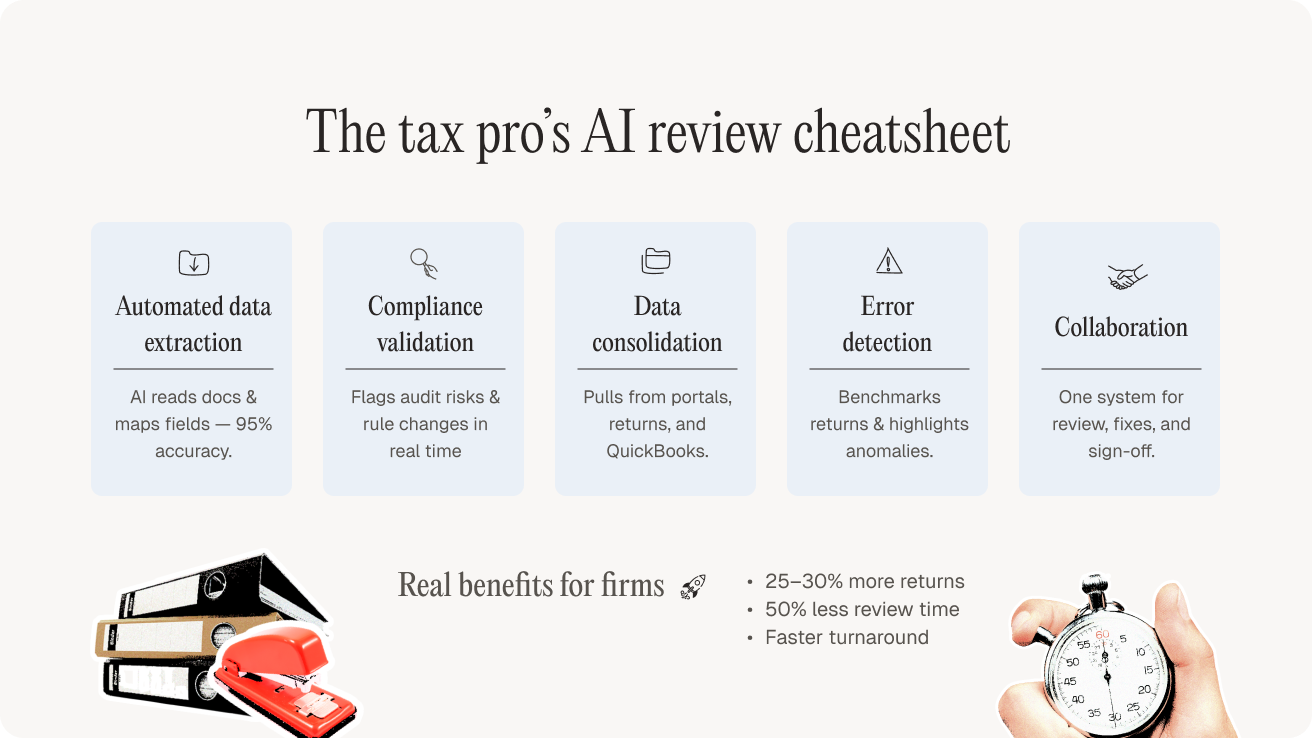Every tax pro knows the choke point isn’t data entry — it’s review. Returns pile up. Staff grind through line-by-line checks. And when client data shows up incomplete or inconsistent, the backlog explodes.
With tax law changing constantly and clients demanding faster turnarounds, firms can’t afford to spend 40% of staff hours on reviews. AI tools are fixing that by stripping the manual work out of the process and cutting review time in half.
How AI tax tools eliminate manual bottlenecks
AI tax tools use technologies like machine learning and natural language processing to complete tasks typically done by humans. Unlike traditional tax software that requires manual input, AI tools learn from data patterns, recognize documents, and make logical decisions.
These systems can read and understand text in scanned documents, identify form fields, and organize information without human intervention. This shift reduces repetitive tasks and minimizes human error.
Let’s take a deeper look.

1. Automated data extraction and classification
Manual typing is dead weight. AI reads W-2s, 1099s, K-1s, and other docs with OCR, pulls out the numbers, and maps them into the return.
Accuracy rates hit 95%+ on standard forms. Hours of typing shrink to minutes of quick review. Now, instead of keying data all day, staff just confirm what’s already there.
2. Instant compliance validation
AI doesn’t wait until the final review to check the rules. It compares entries against current tax laws in real time.
Out-of-range deductions get flagged instantly. Audit triggers are spotted before filing. And when tax law changes, updates are pushed system-wide.
What used to take hours of manual cross-checks is now automated feedback as data flows in.
3. Multi-source data consolidation
Having to chase down mismatches across portals, prior-year returns, and accounting systems is a review killer. AI consolidates data from every source and highlights differences for you.
Example: A client’s 1099-INT shows one number, and QuickBooks shows another. AI flags it on the spot. No more manual hunting across files!
4. Built-in error detection
AI catches the anomalies humans often miss. It compares each return against:
- Prior years for the same client
- Similar returns across the firm
- Expected ranges for income, expenses, or deductions
If a business return suddenly reports half the income with no expense change, it’s flagged. Staff review what matters, not every single line.
5. Real-time collaboration for faster sign-off
Email chains and phone tag kill turnaround. Modern AI platforms keep everything in one system where reviewers flag issues, preparers fix them, and clients respond — all tracked in real time.
The result? Faster reviews, fewer delays, and no more “lost in someone’s inbox” excuses.
Addressing common concerns
- Security: Platforms use bank-level encryption, SOC 2 compliance, and access controls. That’s safer than paper files.
- Accuracy: AI handles extraction, while humans still sign the returns. Nothing leaves your oversight.
- Control: Tools adapt to your workflow. You set the rules, and the system enforces them.
- Integration: FIled works with the major players — CCH Axcess, UltraTax, Lacerte — so you don’t have to rebuild your stack.
Real benefits for firms
- 25–30% more returns handled with the same team
- 50% less review time per return
- Faster turnaround for clients, earlier filing, quicker refunds
.png)
Firms using Filed report higher client satisfaction because reviews move fast, errors drop, and advisory time increases.
The bottom line is, AI doesn’t replace review. It makes review manageable. The grunt work gets automated; your team applies judgment where it counts.
Filed’s platform plugs into your workflow, delivers review-ready returns, and cuts review time in half. We don’t sell hype. We sell speed.
Apply for early access at https://www.filed.com/early-access.
FAQs about AI tax tools
How long does implementation take?
Most firms are live in 2–4 weeks.
What training do staff need?
The tools in Filed mimic existing software, so one or two short sessions are sufficient.
Can AI handle complex returns?
Yes. Multi-state, partnerships, specialized deductions — Filed flags and preps, humans finalize.


.png)

.png)

